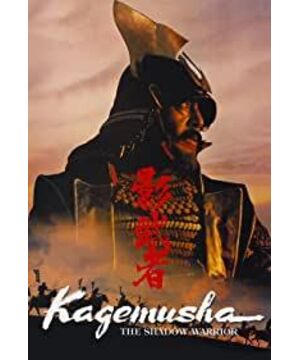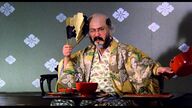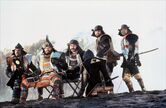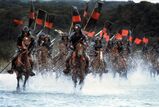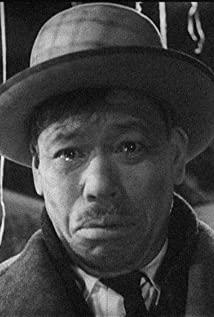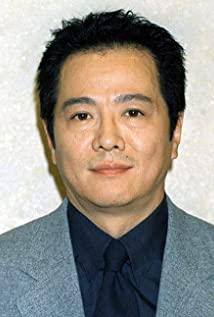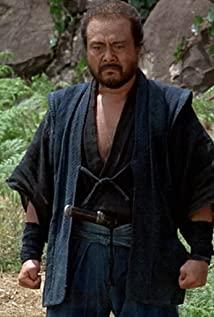"Kagemusha" was released in 1980, at the time of Kurosawa's creation in his later years. Depression and lack of inspiration caused the film master to plunge into the most difficult period of his life, and even chose to commit suicide at one time. The modern film production environment makes Kurosawa feel deeply powerless. His closest partner, Toho, is unwilling to provide funding for the film master’s artistic creation. Since the 1970 "Tram Mania", Kurosawa Akira No work has been published for several years. In 1975, at the invitation of the Soviet Film Bureau, Kurosawa made the film "Delsu Uzala". After that, he fell into the embarrassment of no investment and could only continue his creation in the form of storyboarding.
It wasn't until his two fans, Francis Coppola and George Lucas, who became famous with the "Godfather" series and "Star Wars" series, visited Japan that they learned that the former film mentor had fallen into such an embarrassment. Therefore, we strongly invite the investment of 20th Century Fox and cooperate with Dongbao Film, so that the audience can see this epic masterpiece today.
Fictitious
Realism with fiction is the most commonly used technique by director Akira Kurosawa in movies, and it has been reflected many times in "Kagemusha".
In his previous movie "Spider's Nest", in the scene where the most tragic protagonist, Takeshi Washi, murdered the monarch, the camera did not directly show the entire murder process, but aimed at the protagonist’s wife on the side. His expressionless face set off the madness of the whole scene, and in the movie, it was his wife who encouraged him to murder.
In the beginning of "Kagemusha", the incident of Takeda Shingen's shot was also shown in this way. After explaining Shingen to listen to the flute in the city, the first shot immediately afterwards was the soldiers outside the city of Noda, through them. An onlooker perspective, substituted into the story, enhances the intuitive experience of the entire event. Avoiding direct description, on the contrary, enhanced the expressiveness of this event.
After that, I followed the reaction of Tokugawa Ieyasu and Oda Nobunaga, and interpreting the scene in this way further exacerbated this level of expressiveness. At the same time, from this moment on, the core theme of the film has been revealed, that is, how to build the image of Takeda Shingen from the perspective of the people around him.
Similarly, when expressing grand war scenes in the movie, it is also through profile description. The battle of Gaotian God City only uses the fighting environment around the Kagemusi and the voices outside the picture to reflect the situation of the war.
The film directed by Akira Kurosawa often has this theme, that is, a nostalgia for the old order and the tradition of the old sunlight. When the cold weapon era is gone, when the great man finally falls, I can’t help but ask: the world is still Who can lead us?
Symbolism
Kurosawa's background in painting makes him very sensitive to the rhythm of the colors in the painting and the composition of the characters. At the same time, the use of natural sceneries, such as imagery of wind, water, mountains, and sun, also adds to the heaviness of his films. We can see that Akira Kurosawa's movies carry a kind of classical romance in this way.
When Shingen Takeda died, he deliberately used the mountains in the background to imply the identity of the lord.
In expressing the soldiers' hearts when they withdrew, the setting sun is used to imply pessimism, and at the same time, they lament a fate that is doomed to failure.
A majestic building is used to show Oda Nobunaga's identity, and at the same time, the irritating sound of horseshoes also supplements his inner doubts and anxiety at the moment.
In the last part of the film, a near surreal scene, the thief came to the lake with a spear, and saw Takeda Shingen's banner. He tried to get close and his spiritual will was finally drained and became Shingen. The last martyr of the faith.
Kurosawa Akira, who was shooting this movie, was experiencing the most difficult period of his life, lacking creative inspiration, and the surrounding environment pointed out that Kurosawa Akira was old in his twilight years.
"Kagemusha" is actually, to some extent, a portrayal of Kurosawa's five years and nearly ten years of creative dilemma. He deeply feels that he seems to be out of sync with the current era, and the old traditions are no longer recognized. He poured this sentiment into "Kagemusha" deeply.
The spears of the Takeda army and the cavalry pitted against the muskets of the Oda army, and the attendants who were killed by the muskets in order to protect the Kagemusha were still going to die with the sword. All of these imply the disappearance of our glorious tradition. The honor of samurai and the principles of the samurai world are vulnerable to modern weapons. "Kagemusha" is like a sad elegy to the end of the samurai world written by Akira Kurosawa.
But the emperor of the film industry did not fall. What he firmly believes is his own strong will.
And put all the mood at this time into the movie. The film style of "Kagemusha" is full of classicism and majestic temperament. Kurosawa uses traditional drums, strings and symphonic instrument soundtracks in the movie; and in photography, Turning complexity into simplicity, pursuing a thick and stable visual beauty, photography scheduling also adopts a wide-ranging scheduling method, either static freehand or dynamic pursuit of the ultimate beauty of action.
He has become the "mountain" sitting behind the movie.
The movie not only focuses on a thief, but how it grows from a thief who doesn't change his personality to a shadow warrior who can be fake, and how he deceived everyone with the help of his servants, believing that he is Shingen Takeda.
At the same time, here, there is actually a layer that Kurosawa Akira is also trying to convince the audience that it seems that the thief, he is Shingen Takeda, and he has become Shingen Takeda. He succeeded Takeda Shingen's place in the movie.
But in the end we saw that this was a lie after all. The shadow warrior was triumphant, fell off his horse, and pierced the illusion of self-deception made by the vassals and the shadow warriors.
Will to faith
The first shot of the movie is a very long, fixed-position long shot. Director Akira Kurosawa put this scene in the most important prologue part of the movie, and its profound meaning is obvious.
In the picture, there are three characters. From left to right, Takeda Shinren, who sits in the second highest position, Takeda Shingen who sits in the highest position, and the thieves who are in the lowest position, are clearly distinguished by class. Takeda Shingen is the center of power in the Takeda family. Not only sits in the top position, but at the same time he is also the center of the picture.
In this picture, the candlelight is the only light source, shifting the visual focus of the picture to the right. In essence, this lens is also focused on showing the relationship between Takeda Shingen and the thieves.
There seem to be three characters in the picture, but in fact there is a "fourth person" in the picture. The fourth "person" is the shadow of Takeda Shingen who was hit by candlelight on the wall. In this composition, it seems that the shadow is the most important "person" in the lens. In this composition that extremely expresses the power class, the shadow is higher than the lord Takeda Shingen.
Especially when Takeda Shingen stood up, the shadow behind him appeared more majestic and mighty than himself, and the person was shrouded in the shadow of the majesty of the shadow at this time.
The shadow obviously occupies the highest position in this picture. What does it represent? I think what it represents is the "belief" in Shingen Takeda. This belief comes from Shingen Takeda, but at the same time it surpasses him. It represents the "Takeda Shingen" in the hearts of his retainers, including the Kagemusi. The existence of this shadow itself is vague and unknowable because it only exists in the subconsciousness of people who are familiar with Xinxuan.
This is why after Shingen's death, so many people, including Nobunaga and Tokugawa Ieyasu, responded to so many people. Kurosawa reveals Takeda Shingen's position in the movie in this way. What people admire and awe in is an abstract "person" who is wise, firm and powerful. Such belief in an "abstract person" is the spiritual pillar of the entire Takeda Group.
From this point of view, including the thieves, including Takeda Shinren, including all the sergeants, and even Takeda Shingen himself became the "Takeda Shingen" in people's hearts, that is, the shadow warrior of that great belief. The externalization of this belief in the movie is the combat creed of "wind, forest, fire, and mountain" in the movie.
In the movie, the image of Takeda Shingen is always missing in the movie. There are only a few shots that directly show Takeda Shingen. There are only four shots, including the long shot in the prologue.
Including the beginning of the prologue and entering the feature film, Takeda Shingen is the first to enter everyone's sight. He is not Shingen Takeda, but a shadow warrior disguised by Takeda Shinren.
The disappearance of the character of Shingen Takeda at the beginning of the movie also paved the way for the inner crisis of the shadow warrior, the thieves behind.
The separation of Takeda Shingen's characters makes us unable to intuitively, and we can only indirectly see what kind of person Takeda Shingen is from the perspectives of people around us. This also allows Kurosawa Akira to synchronize the perspectives of the audience with the characters in the film. The audience has built up the effect of the leader Xin Xuan in the hearts of everyone.
We learned from these "aftermaths" that the normal operation of such a huge military system is inseparable from such a common belief, and this belief is Takeda Shingen. As long as it is believed that Shingen Takeda is still alive, the military will not disperse; as long as the mountain sits still, a strong will will continue to support the military.
So at the end of the film, a unit that has lost its sense of belonging and faith, in fact, died long before the arrival of the mighty musket, but it is still advancing for a faith that remains unbearable. They became martyrs to the creed of Takeda Shingen's "Fujirinvolcano".
There is a scene at the end of the film, facing the army seat where both Takeda Shingen and Kagemusi have sat. What this shot shows is not only the former Takeda Shingen and the former Kagemusi, but also the countless Kagemusic behind this army.
In the movie, the collapse of the Takeda clan also implies the end of an era. The Kagemusha vainly attempted to save an era doomed to pass on his own. It is ultimately futile. A sense of fatalistic tragedy emerged spontaneously.
Shadow Warrior
The shadow warrior in the movie, or more should call him: thieves. He is a character with his own tragedy and destiny. The thieves have a set ending, that is, Shingen Takeda, who he plays, will eventually be seen through and lead to failure. His failure is inevitable. No matter how successful he plays, once three years are up, he will still be just a shadow warrior.
So he plays Takeda Shingen, and this event itself is a doomed performance.
Look at this lens again. In the picture, the coexistence of Takeda Shingen's body and shadow in the picture symbolizes the integrity of his ontology. The incompleteness of Takeda Shinken and the thieves is used to reflect Takeda Shingen's completeness, which coincides with the deprivation of Takeda Shingen's power, and also implies feudalism. The power of the times deprives everyone of their identity.
The deprivation of personal identity is also the biggest source of tragedy in the shadow warriors.
The issue of personal identity is also a core proposition of "Kagemusha". This proposition is divided into two parts.
That is to say, the Kagemusha faces the fear of taking the identity of Shingen Takeda, and the huge emptiness caused by the entry of an alien identity to the ontology.
In the film, the Kagemusha has risen from an obscure soldier within the military group of the entire Takeda family, and has become the lord who is admired by thousands of people.
This kind of improvement of character identity, which can be said to be completed in an instant, is like a dream for Kagemusha. He completed the ascension of the performance through the instant change of identity. But with the extreme performance comes the questioning of the identity of the self.
The most important scene in the film that shows doubts about identity is the dream scene in the middle of the film.
This scene took place after the key family meeting in the film. Kagemusha refuted Takeda's trust at the meeting. This was an attack on Takeda Shingen's identity. Although he has become Takeda Shingen in front of others, his identity is still very far away from his self.
In the early stage of the film, the thief refused to accept becoming a Kagemusi and refused to play Takeda Shingen. To a certain extent, this rejection is the rejection of the image of Takeda Shingen as a feudal power by the thieves, and the rejection of a kind of power consciousness against the noumenon of freedom. Acting as someone else, or we say that acting is dangerous, because in the process of acting, we don't know when we can't distinguish between ourselves and the acting person.
It's like a mask that can't get rid of the deep imprint on the body, performance has a deep cannibalization of the id.
This is actually a bit like the performance itself. The performance itself is to a certain extent the process of destroying the self and allowing other personalities to settle in. The performances we are pointing out here are not only performances on theatrical stage, but also performances in life.
Just like in the movie, the Kagemusha tries to play Takeda Shingen, he can get through everything in the daytime, but subconsciously, this level of identity actually brings him a deep fear of primitive personality; Takeda Shingen's identity as a "guest" In fact, to a certain extent, he has already turned against the guest, and defeated the thieves who are the masters.
The painstaking pursuit of personal identity is also a problem that everyone has to face in the face of society and life. Everyone in modern society cannot get rid of the conflict between social identity and personal identity. We use social identity to obtain material production materials to support our personal identity. However, subtly identity entry and conflicts of interest invade individuals all the time. The existence of identity, whether it exists or not, or whether its existence is recognized by people brings an extreme and indescribable fear to individuals.
This was his fear in the first half, and at the same time, the Kagemusi not only had to face the backlash of his own thief status by the Shingen as a guest, but also the anxiety about whether Shingen's personal identity existed.
The first half of the film dispelled the existence of Takeda Shingen, and made Kagemusha fall into such suspicion. The presence of an inconclusive identity into the ontology creates not only a doubt about the existence of the stationed identity, but also a doubt about the existence of the id.
Therefore, in the next second, he was struggling to follow in Xinxuan's footsteps, and he was eager to be free from doubts about his identity. When Xinxuan's identity as a guest disintegrated the master's identity of the thieves, the Kagemusi found that in the entire personal identity contest, the identities struggled to death and death, and the specific "person" was the target to be destroyed. At this moment, the emptiness caused by the desire for identity hurts him deeply. At this moment, all he desires is just an identification of identity.
At this moment, we seem to be able to discover that the pursuit of identity gives the two parts of personal identity issues the same spiritual root.
In the last scene in the movie, the torn thief finally faces Takeda Shingen’s beliefs, eager to gain identity for self-liberation, and finally regains his identity as a shadow warrior in sacrifice and martyrdom, becoming Takeda Shingen’s personal will. A part of a collectivistic power.
View more about Kagemusha reviews


